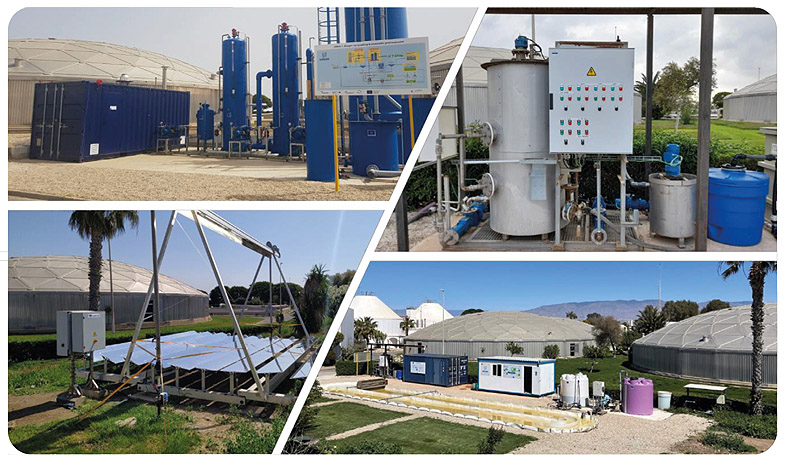The recent revision of the EU Directive on Urban Wastewater Treatment (UWWTD) calls for stricter discharge standards, as well as achieving energy self-sufficiency in the 22,500 plants (WWTP) in Europe. Today, these facilities consume 15,000 GWh/yr of electricity, corresponding to two nuclear power plants of 1,000 MW. To minimize the environmental impact and carbon footprint of WWTP, five low-cost technologies to produce useful resources from wastewater were demonstrated at the El Bobar WWTP in Almería (Spain), as part of the LIFE project Ulises, funded by European Union under Grant Agreement no. LIFE18 ENV/ES/000165.
In traditional WWTP, excess sludge is transformed in anaerobic digesters into biogas, normally used in cogeneration engines to cover part of the electricity needs of the plant. In Ulises, the raw biogas was upgraded to biomethane, meeting the requirements for vehicular use (UNEEN 16723-2) with the ABAD Bioenergy® system, and this renewable biofuel was tested in a fleet of passenger cars. Since the beginning of the project in July 2019, the vehicles have travelled more than 21,000 kms in urban and extra urban cycles, with an average consumption of 4.8 kg of biomethane per 100 km driven.
To replace the conventional aerobic treatment process in the water line, an Upflow Anaerobic Sludge Blanket (UASB) reactor was operated at ambient temperature to remove organic matter from wastewater and produce biogas. Thanks to a novel pulsed feeding system PUSH® (European Patent EP 3009408), this pre-treatment removes more than 90% of raw wastewater solids (TSS), as well as more than 75% of the chemical oxygen demand (COD) with a Hydraulic Retention Time of 12 h. Per m3 of treated wastewater, gas production can reach up to 100 L, containing close to 80 % of CH4 – which allows to generate about 1 kWh of thermal energy – compared to conventional aeration that consumes up to 0.5 kWh/m3 of electricity, and produces five times more excess sludge.
To reach reclaimed water quality requirements for agricultural irrigation, a novel photo-Fenton process using H2O2 dosing to generate hydroxyl radicals was tested with a Raceway Photoreactor on a scale of 100 m2 to eliminate pathogens and micropollutants. Class B of the new water reuse regulation EU 2020/741 with an E.coli number of less than 100/100 ml could be reached with up to 2 m3/m2/d at acidic pH.
Furthermore, 85% removal of Contaminants Emerging Concern (CEC) was achieved, to meet the requirement of the new UWWTD 2022/541 for the elimination of micropollutants and drugs such as venlafaxine, ketoprofen or diclofenac, that are not sufficiently eliminated in conventional treatment.
In addition to obtaining high quality reuse water, Ulises tested two different processes to recover nutrients as a valuable product, working on both the solid and liquid phase after centrifugation of the sludge:
- Enzymatic hydrolysis of dewatered biosolids generate biofertilizers based on peptides and amino acids, with biostimulant properties for plant growth.
- Struvite precipitation is applied on the concentrate obtained with a membrane-based system
